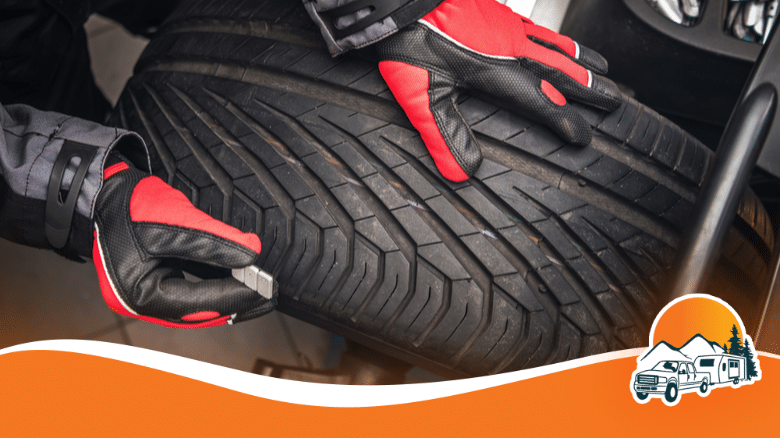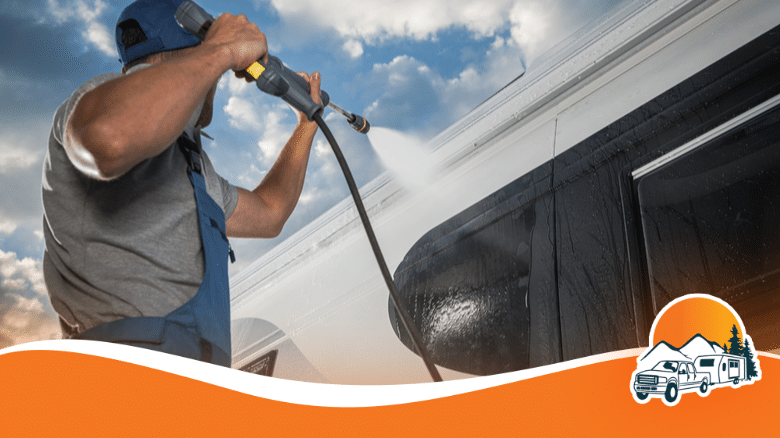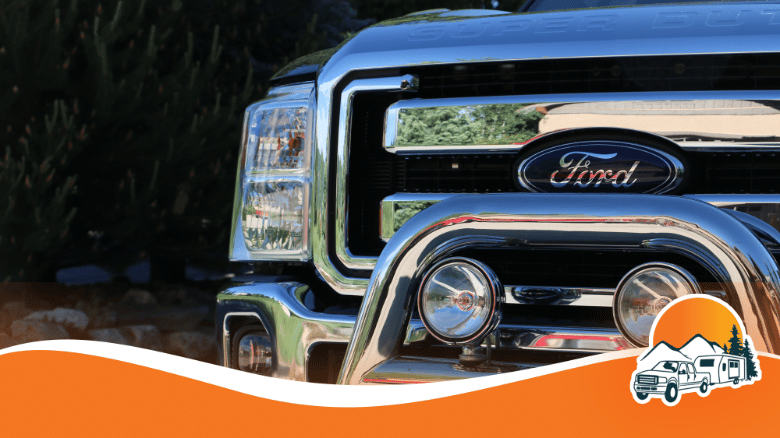A weight distribution hitch is essential for anyone who needs to tow a trailer, RV, or any other heavy load using their vehicle.
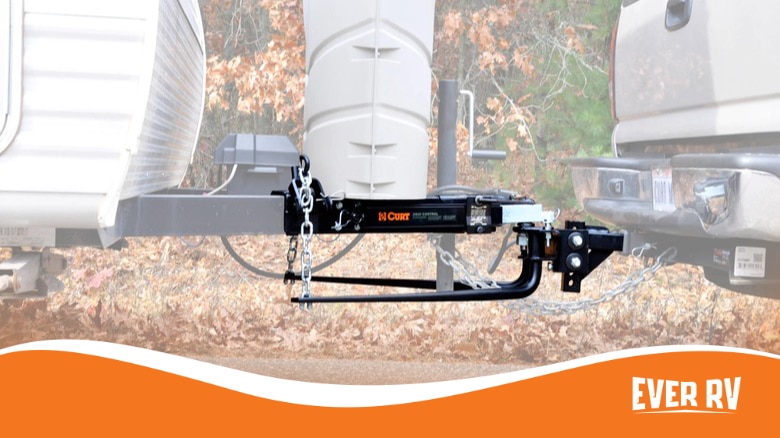
And if you’ve been wondering, “Weight Distribution Hitch?”. This type of hitch helps distribute the weight evenly across the vehicle-towing system, preventing dangerous situations that can occur when too much weight is concentrated on the rear of your towing vehicle.
By ensuring an even distribution of weight, you’ll experience improved stability, better handling, and increased safety on the road.
Key Takeaways
- A weight distribution hitch improves stability and safety when towing heavy loads.
- Different hitch systems are available, and choosing the one that suits your needs is crucial.
- Proper installation and setup are essential to optimize the effectiveness of your hitch system.
Understanding the different types of weight distribution hitches available on the market is crucial in selecting the right one to suit your specific needs.
Various components are included in a typical hitch system, such as sway control bars and spring bars, which work together to manage weight distribution effectively.
It’s also important to consider your vehicle’s weight and towing capacity, as not every hitch system is suitable or compatible with every type of towed load.
Installing and setting up a weight distribution hitch involves a proper understanding of the system’s components and functioning.
Many products and brands are available to choose from, each with its benefits and features. Ensuring the right hitch system for your setup leads to a safer and more enjoyable towing experience.
Basics of Weight Distribution Hitches
What It Is
A weight distribution hitch is a towing accessory designed to improve your overall towing experience.
It’s an essential component when towing a heavy trailer with your vehicle, as it helps distribute the weight of the trailer more evenly across your vehicle’s axles.
This ensures that your vehicle remains level and your trailer stays securely attached, providing a smoother and safer ride.
Weight distribution hitches comprise a few key components: the hitch head, spring bars, and the brackets attached to the trailer frame.
These parts work in concert to effectively distribute the weight and alleviate stress on your vehicle’s suspension system.
Its Purpose
The main purpose of a weight distribution hitch is to improve the stability and handling of your vehicle when towing a trailer.
When you attach a heavy trailer to your vehicle, the added weight can cause your vehicle to sag at the hitch point, leading to uneven distribution of the load on your vehicle’s axles.
This can have several negative effects, including:
- Reduced steering and braking control
- Excessive tire wear
- Diminished headlight aim
Using a weight distribution hitch can mitigate these issues and ensure a safer, more comfortable towing experience.
The hitch works by transferring the weight from the rear of your vehicle to all axles, effectively leveling your vehicle and trailer. This balance promotes better steering, braking, and overall handling.
Remember, a weight distribution hitch is not a one-size-fits-all solution.
When choosing the right hitch for your towing needs, be sure to consider factors such as your vehicle’s towing capacity, the weight of your trailer, and the hitch’s weight rating.
By making an informed decision and using a weight distribution hitch correctly, you can tow with confidence and increase the safety of your journey.
Types of Weight Distribution Hitches
Round Bar Hitches
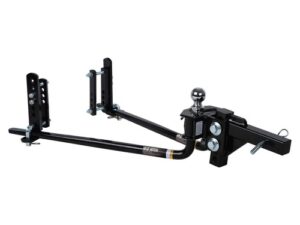
Round bar hitches are a popular choice for weight distribution systems.
These hitches utilize round spring bars that attach to the hitch head and extend outwards, connecting to the trailer frame.
The bars apply leverage to evenly distribute the weight evenly, providing a more stable and secure towing experience.
Here are some benefits of round bar hitches:
- Ease of use: Installing and adjusting these hitches is relatively straightforward, making it an appealing choice for those new to towing.
- Affordability: Round bar hitches are generally less expensive than trunnion bar hitches, making them an attractive option for budget-conscious customers.
- Compatibility: These hitches work well with trailers that have lighter tongue weights.
However, there are also some potential drawbacks:
- Clearance: Round bar hitches may not provide enough ground clearance for vehicles with low-hanging accessories or large rear tires.
Trunnion Bar Hitches
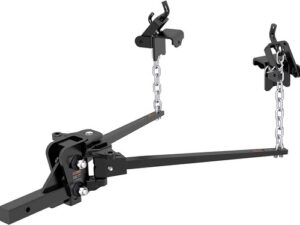
Trunnion bar hitches are another type of weight distribution system. They use square spring bars that slide into the hitchhead.
These bars extend outwards, connecting to the trailer frame like round bar hitches.
Some benefits of trunnion bar hitches include:
- Weight capacity: Trunnion bars typically have higher weight capacities than round bars, making them suitable for heavier trailers and loads.
- Ground clearance: These hitches offer better ground clearance, which can be especially important for off-road vehicles and those with low-hanging accessories.
- Adjustability: Trunnion bars often provide more options for precise adjustments.
However, trunnion bar hitches also have potential downsides:
- Cost: These hitches can be more expensive compared to round-bar hitches.
- Complexity: The installation and adjustment process for trunnion bars may be more complicated, potentially requiring extra tools and time.
As you evaluate your towing needs, consider the differences between round bar and trunnion bar hitches. Select the appropriate hitch that best suits your vehicle, trailer, and towing requirements.
Components of a Hitch
A weight distribution hitch is essential when towing heavy loads, as it helps evenly distribute the tongue weight across your tow vehicle and trailer’s axles.
This hitch has several components that work together to maintain stability and reduce sway. Here, we will discuss the main components of a weight distribution hitch.
Hitch Head – The hitch head is the central part that connects the tow vehicle and trailer. It houses the trailer ball and provides a mounting point for the spring bars. The hitch head is designed to pivot, allowing better articulation between the tow vehicle and the trailer.
Shank – Connecting the hitch head to the tow vehicle’s receiver is the shank. It slides into the receiver and is secured with a pin and clip. Some shanks are adjustable, letting you fine-tune the setup for optimal weight distribution.
Spring Bars – These bars are crucial in redistributing the tongue weight. Two types of spring bars are available: round bars and trunnion bars. Round spring bars are attached to the hitch head via chains and brackets, while trunnion bars are mounted directly onto the head assembly. Both bars transfer load from the rear axle to the front axle, ensuring a more balanced weight distribution.
Brackets – Positioned on the trailer frame, brackets serve as attachment points for the spring bars. They are adjustable, allowing you to set the desired tension and height for your setup. The tension on these brackets is crucial for maintaining the effectiveness of the hitch.
Hitch Ball – Attached to the hitch head, the hitch ball is the connecting point between the tow vehicle and the trailer. Selecting the right ball size that matches your trailer’s coupler is essential.
Ball Mount – Another critical component of the hitch is the ball mount. It works together with the hitchhead to provide a secure connection between the tow vehicle and the trailer.
Sway Control – Some weight distribution hitches include sway control features, which help minimize trailer sway caused by wind or other factors. These systems utilize built-in friction or additional accessories, like sway bars or dampening mechanisms.
Remember to choose a hitch that matches your tow vehicle’s capabilities and the weight of your trailer.
By understanding each component’s function, you can ensure proper setup and experience a smoother, safer towing experience.
Weight and Towing Capacity
When towing a trailer, it’s essential to consider the towing capacity of your vehicle and the weight distribution hitch.
The towing capacity refers to the maximum weight your vehicle can safely tow, and it’s determined by its Gross Vehicle Weight Rating (GVWR).
This information can typically be found in your vehicle’s owner’s manual.
The trailer weight or Gross Trailer Weight (GTW) is the combined weight of the trailer and its cargo.
To safely tow heavier loads, you must ensure that your towing vehicle has the appropriate towing capacity and is compatible with a weight distribution hitch.
This hitch helps to balance and distribute the load evenly across the axles of the towing vehicle and trailer, enhancing stability and control.
When calculating the overall weight of your towing setup, there are a few factors to consider:
- Towing vehicle’s GVWR: This number is the maximum allowable weight of a fully loaded vehicle (including passengers, cargo, and fuel), and it is essential not to exceed it for safety reasons.
- Gross Trailer Weight: This includes the weight of the trailer and its payload.
- Tongue Weight: It represents the downward force exerted on the hitch by the trailer coupler. As a general rule of thumb, tongue weight should be around 10-15% of the total trailer weight.
By selecting the appropriate weight distribution hitch based on your towing vehicle’s capacity and your trailer’s weight, you can safely and efficiently tow heavier loads, such as a gooseneck trailer.
Remember that exceeding your vehicle’s towing capacity could result in mechanical failure and reduced vehicle control and may void your manufacturer’s warranty.
So, always ensure that you adhere to the limits and guidelines set by your towing vehicle’s manufacturer.
Installation and Setup
To begin with the installation of a weight distribution hitch, make sure your towing vehicle and trailer are parked on level ground, coupled, and unloaded.
This will provide an accurate starting point for your setup.
First, measure and take note of your towing vehicle’s ground clearance at the rear wheel wells.
Next, attach the hitch head to the shank and set the assembly into the receiver of your towing vehicle. Make sure to insert the hitch pin to secure the hitch head assembly in place.
Once the hitch head is secured, slide the weight distribution bars into the designated sockets on the hitch head. Secure them in place with the provided pins.
Now, you can begin adjusting the tilt of the hitch head. This will help you achieve proper weight distribution by setting the correct tension on your weight distribution bars.
You might have to do some trial and error to establish the right angle, so keep your measurements recorded for future reference.
When you have the hitch head adjusted, it’s time to attach the hookup brackets to your trailer’s frame.
These brackets should be positioned about 30 inches back from the trailer coupler.
Consult your weight distribution hitch manual for specific measurements.
When you have the brackets installed, raise your trailer using the trailer jack to take the weight off the hitch head and bars.
With your trailer raised, you can now hook up the weight distribution bars to the brackets using the provided chains.
The chains should be tight enough to provide tension but with a little give when hooked up. You might need to adjust the number of chain links to get the best fit and weight distribution.
Finally, lower your trailer back onto the hitch, reconnect your breakaway chains and breakaway cable, and double-check all connections for safety.
You have successfully installed and set up your weight distribution hitch.
Make sure to monitor the system during your first few trips, checking for any adjustments that may be needed along the way.
Products and Brands
When looking for a weight distribution hitch, it’s essential to consider the various products and brands available in the market.
One of the popular brands offering high-quality weight distribution hitches is Curt.
Their TruTrack™ system is a combination of a weight distribution hitch and a sway control system designed to provide a smoother and more controlled driving experience.
The TruTrack™ system ensures stability and safety by evenly distributing the trailer’s weight across the tow vehicle’s axles.
This improved weight distribution helps maintain proper balance and reduces sway while towing.
The integrated sway control helps counteract any sway caused by crosswinds or other factors, keeping your trailer stable on the road.
Some of the notable features of the Curt TruTrack™ system include:
- Sway Control: The integrated sway control system can be fine-tuned to match your specific towing situation, giving you optimal control.
- Adjustable Support Brackets: Easily adjustable brackets ensure the proper fit for your trailer, allowing you to adapt to various tongue weights and sizes.
A table highlighting essential specifications of the Curt TruTrack™ system:
| Specification | Details |
|---|---|
| Weight Capacity | Up to 15,000 lbs (with specific models) |
| Tongue Weight Range | Up to 1,500 lbs (with specific models) |
| Hitch Shank Length | 12 inches (adjustable) |
In conclusion, the Curt TruTrack™ is a reliable option for those seeking a weight distribution hitch that also offers sway control. It’s a product built with quality, dependability, and ease of use in mind, making it an excellent choice for your towing needs.
Benefits and Safety
A weight distribution hitch offers numerous benefits, enhancing the safety and control of your towing experience.
You can be confident in a more stable and controlled ride by evenly distributing the weight across the axles of your tow vehicle and trailer.
One significant advantage is the improvement in your vehicle’s braking power.
When weight is more evenly distributed, you gain better traction, which leads to more effective braking.
This feature is especially important during emergency stops or in poor weather conditions.
With a weight distribution hitch, you’ll also notice a reduction in trailer sway.
The hitch system works by applying leverage to create a more balanced and secure connection between your vehicle and the trailer.
This process significantly minimizes the effect of wind gusts, passing vehicles, and uneven road surfaces, making your trip safer and more enjoyable.
Another benefit is the ability to maintain a proper ride height.
By using rise and drop adjustments on the hitch, you can ensure your tow vehicle and trailer remain level.
This feature not only ensures a smooth ride but also prevents any unnecessary stress on your coupler and vehicle suspension.
Frequently Asked Questions
How does a weight distribution hitch work?
A weight distribution hitch works by redistributing the tongue weight of the trailer across the vehicle’s axles, improving stability and control. When you connect your trailer to the tow vehicle, the tongue weight, which is the downward force on the hitch, can cause the rear of the vehicle to sag and the front to rise. This affects steering, braking, and overall handling. A weight distribution hitch solves this problem by using spring bars to distribute the weight more evenly across both the front and rear axles.
What are the essential parts of a weight distribution hitch?
There are four main components in a weight distribution hitch:
- Shank: The shank connects the hitch to the vehicle’s receiver.
- Head assembly: The head assembly secures the shank and provides a mounting point for the spring bars.
- Spring bars: These bars transfer the tongue weight across the axles for better weight distribution.
- Trailer brackets: The brackets attach to the trailer and connect to the spring bars, enabling the weight transfer.
How do I determine if I need a weight distribution hitch for my trailer?
To determine if you need a weight distribution hitch, check the following:
- Vehicle and trailer weight ratings: Consult your vehicle’s owner manual to find the Gross Vehicle Weight Rating (GVWR) and the maximum tongue weight. You will need a weight distribution hitch if your trailer’s Gross Trailer Weight (GTW) or tongue weight exceeds the recommended limits.
- Handling and stability: If your vehicle experiences sway or instability when towing, a weight distribution hitch can help improve these issues.
What is the difference between a weight distribution hitch and a regular hitch?
The main difference between a weight distribution hitch and a regular hitch is in how they handle weight distribution. A regular hitch, also known as a “simple ball hitch,” only attaches the trailer to the tow vehicle. It does not redistribute the tongue weight; this can lead to issues with vehicle stability and handling. A weight distribution hitch, on the other hand, evenly distributes the tongue weight across the vehicle’s axles for better control and stability when towing.
Are there any disadvantages to using a weight distribution hitch?
Some potential disadvantages of using a weight distribution hitch include:
- Cost and complexity: Weight distribution hitches tend to be more expensive and complex to set up compared to regular hitches.
- Compatibility issues: Not all trailers and tow vehicles are compatible with weight distribution hitches. Always check the manufacturer’s recommendations before making a decision.
- Potential ground clearance loss: Weight distribution hitches can sometimes reduce ground clearance, making it harder to navigate uneven terrain.
How can I calculate the appropriate weight distribution hitch for my towing setup?
To calculate the appropriate weight distribution hitch for your towing setup, follow these steps:
- Determine your trailer’s tongue weight: The tongue weight should be 10%-15% of your trailer’s GTW. You can measure this using a tongue weight scale or by estimating with a bathroom scale.
- Find your vehicle’s towing capacity and hitch ratings: Consult your owner’s manual for your vehicle’s towing capacity, GVWR, and maximum tongue weight rating.
- Select a weight distribution hitch with compatible ratings: Choose a weight distribution hitch with weight ratings that match or exceed your trailer’s tongue weight and your vehicle’s towing capacity, ensuring proper weight distribution and safe towing.
Featured image by Lippert

